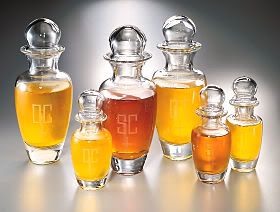 If you need to purchase new Holy Oil Vessels, we recommend vessels from Meyer-Vogelpohl. The most common style vessel used in our diocese is their MV200 or MV201 set. You can get more purchasing information on this set by clicking here.
If you need to purchase new Holy Oil Vessels, we recommend vessels from Meyer-Vogelpohl. The most common style vessel used in our diocese is their MV200 or MV201 set. You can get more purchasing information on this set by clicking here.However, your Holy Oil vessels need not be limited to this style of vessel. Here are some things to consider when deciding on purchasing a vessel for your oils.
Beauty and Dignity
Any vessels used for liturgy should be beautiful and dignified. They should show care in craftsmanship and appropriateness for its liturgical use. Clear glass is good because you can see the oil, but vessels with some colored glass can also show off the oil. Plastic vessels are not appropriate. Well-crafted and dignified metal containers might be appropriate, but they may be more difficult to clean than glass containers.
Liturgical Use
These vessels are not simply pieces to be admired in an ambry (a niche or box in a sanctuary wall where holy oils are stored; usually placed near the baptismal font) like museum artifacts but are meant to be used during liturgies of anointing. Therefore, parishes should have at least one set of vessels that can be carried and held easily during a liturgy. If larger vessels are kept in an ambry, then smaller portable vessels can be filled from them.
What do OC, OI, SC, OS mean?
These are acronyms for the three different types of oils used--Oil of the Sick, Oil of Catechumens, and Sacred Chrism. Older vessel sets used the initials SC for Sacred Chrism, OI for Oil of the Sick (infirm), and OS for Oil of Catechumens. Newer sets have changed OS to OC for Oil of Catechumens. In any case, you should be able to distinguish which oil is in which vessel. Most parishes use vessels marked with SC for Chrism, OI or OS for Oil of the Sick, and OC for Oil of Catechumens.
S.C.: sanctum chrisma
ReplyDeleteO.S.: oleum sanctum
O.I.: oleum infirmorum
Let's not forget this is the Latin particular Church.
While not expressly forbidden, the use of glass vessels for the sacred oil should be discouraged. Saint Charles Borromeo developed quite specific rules for storage of the sacred oils in the 16th century. These rules are used virtually unchanged today. Thus, sacred oils should be in vessels of silver or pewter. Often the interiors of the vessels are indeed glass.